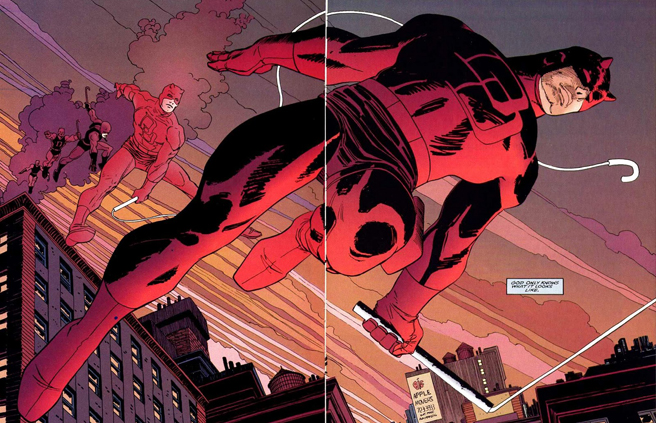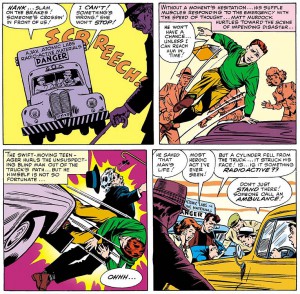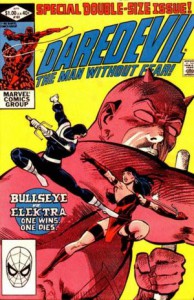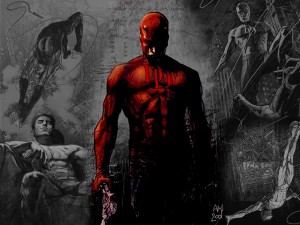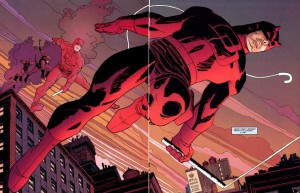
Matthew “Matt” Murdock
First Appearance
Daredevil #1 April. 1964
Nicknames & Aliases
The Man Without Fear, Hornhead, DD, Mike Murdock, Ronin
Powers and Abilities
Daredevil’s senses are enhanced to super-human levels, meaning he can tell if a person is lying by listening to whether their heartbeat skips when they speak, or read a newspaper by running his fingers over the print and feeling the letters raised off the page. He also possesses a superhuman “radar” sense, which enables him to detect objects around him and warns him of danger.
Additionally, Daredevil is a highly-trained acrobat, gymnast, martial artist, and an accomplished lawyer.
Weaknesses and Achilles’ Heels
Well, he’s blind, so there’s that. Additionally, his enhanced senses can also be a hindrance, as he’s much more susceptible to sensory extremes (ie a sudden loud noise is even louder for Daredevil).
He also has an inclination towards martyrdom and falling for women at the wrong times.
Gadgets & Accessories
Daredevil’s signature weapon is his billy club, a combination melee weapon/grappling hook that disguises itself as his cane.
Friends & Allies
Foggy Nelson (his best friend/ex-law partner), Karen Page (the first love of his life), Milla Donovan (his estranged wife), Elektra, Black Widow (Natasha Romanoff), Echo (Maya Lopez), Luke Cage, Iron Fist (Danny Rand), Spider-Man (Peter Parker), Dakota North, Jessica Jones, Stick (his martial arts mentor), Kirsten McDuffie (his current girlfriend and law partner).
Foes & Antagonists
The Kingpin (Wilson Fisk), Bullseye, the Owl, the Jester, Typhoid Mary, Stilt-Man, Mister Fear, Gladiator, Purple Man, the Hand.
Movies and Appearances
Daredevil’s live action debut came in the form of an appearance in the Trial of the Incredible Hulk TV movie, which functioned as a backdoor pilot for a never-realized Daredevil series. After that, he headlined his own somewhat underrated movie in 2003, starring Ben Affleck as the titular hero. Currently, he’s starring in Netflix‘s first original Marvel series, played by Charlie Cox.
One Sentence Origin
Hit by radioactive chemicals after saving someone’s life, young Matt Murdock loses his sight but gains heightened senses, growing up to fight for justice as a lawyer by day and by night as the costumed Daredevil, the Man without Fear!
Fun Fact
The popular ninja-laden tales of Frank Miller’s early 80s run on Daredevil was one of the inspirations for Kevin Eastman and Peter Laird’s Teenage Mutant Ninja Turtles, who were created as parodies of the some of the most popular comics at the time.
Memorable Moment
Daredevil #229, April 1986: The Kingpin, having learned Daredevil’s secret identity and used that knowledge to utterly destroy Matt Murdock before having him killed, is nagged by the thought that no corpse for Matt Murdock was ever found, a thought which eats away at him as he realizes that if Murdock is somehow still alive, the Kingpin has turned him into an even more dangerous foe, as a man without hope…is a man without fear.
Austin’s Analysis
Daredevil is a character more or less defined by two extended runs by two specific creators. Created in 1964 by Stan Lee and Bill Everett in a clear attempt to tap into the success of Spider-Man, Daredevil has one of the all time great superhero hooks: he’s a blind lawyer who puts on a superhero costume and takes the law into his own hands. Unfortunately, that hook only takes the character so far, and like the X-Men, Daredevil existed in his early years as something of an also-ran at Marvel, existing in the shadows of Lee & Kirby’s Fantastic Four and Thor, or the Lee/Ditko/Romita Amazing Spider-Man. Like the X-Men, that doesn’t mean Daredevil’s early years don’t have their fair share of entertaining stories and strong artistic contributions (in particularly, Gene Colan’s work on Daredevil is highly regarded) as a variety of creators worked on the series and tried out different settings (including an extended run with Daredevil operating in San Fransisco) and tones (including everything from sci-fi to horror). But nothing ever really took, and few developments lasted beyond their introductory creator’s tenure on the title. A long-term partnership with Black Widow helped stave off cancellation in 1971, but by the late 70s, Daredevil’s series was once more hovering near cancellation.
But like X-Men, Daredevil was revitalized through the work of a specific creator. Starting in 1979, Frank Miller, first as artist and then as the writer/artist, cast Daredevil firmly in the noir tradition, transforming a traditional superhero book into, essentially, a work of urban crime fiction. Daredevil’s biggest nemesis became Wilson Fisk, the Kingpin of crime, and the character became mired in the urban grit of the war on organized crime. Gone was the swashbuckling. Daredevil was recast as an intense antihero, more Wolverine than Spider-Man. The superhero trappings, the costume and the radar sense, remained, and to them, Miller added martial arts elements and a group of evil ninjas called the Hand, but Miller also gave the character new purpose and a distinctive identity as the most street-level of Marvel’s street level characters, an intense warrior fighting crime itself.
Eventually, Miller left the series but returned a few years later to write “Born Again”, in which he deconstructed the character even further, bringing Matt Murdock to his lowest point yet before building him back up in what is considered one of the all time great Marvel stories. Decades passed, and other creators lent their vision to Daredevil, but all of them were now working in the shadows of Miller, whether embracing his aesthetic or pushing against it, and Daredevil once more slipped into the lower tier of Marvel heroes, overshadowed by big, noisy events in the 1990s led by the X-Men and Spider-Man. But a high-profile relaunch by director Kevin Smith put the character back on fans’ radars (and back on the sales charts), which opened the door for the second defining creator run on the series.
From 2001 to 2005 Brian Michael Bendis, a relative unknown at the time, with a series of, amongst things, crime stories under his belt, followed in the footsteps of “Born Again” by once more breaking the character down, examining what makes Matt Murdock do what he does while pushing him ever closer to his breaking point. In Bendis’ hands, Daredevil never seemed able to catch a break. Early in Bendis’ run, he revealed Daredevil’s secret identity to the Marvel Universe, then spent much of the rest of his tenure on the title taking the time to explore the ramifications of that act, what it would mean for the character as both a superhero and a lawyer to deal with being publicly outed. Though still grounded in the noir aesthetic of Frank Miller, Bendis’ run packed a punch nonetheless, making fans take notice of the character once again and helping launch the career of a writer who would eventually serve as, essentially, the architect of the entire Marvel Universe.
As with Miller, later creators working on the character post-Bendis have done so in response to the work Bendis did with the character, either directly continuing what he did by bringing the character to lower and lower points (including time spent as the leader of the Hand), or by reacting against it, as Mark Waid is doing in the current Daredevil series, a conscious effort to push back against the gritty noir setting by embracing the more swashbuckling elements of the character’s earliest days. Waid’s interpretation is certainly not the end of the character, but it does make for a nice “full circle”, especially with Daredevil poised to breakout as the star of Marvel’s first Netflix-original TV series, a series that, from the early looks, is drawing heavily on the Miller/Bendis noir approach. Which makes sense, of course. Without the work of those creators, particularly Miller, Daredevil may not be more than a curious footnote in the history of Marvel Comics, instead of the multimedia star and distinctive element within that large Marvel tapestry he is.

